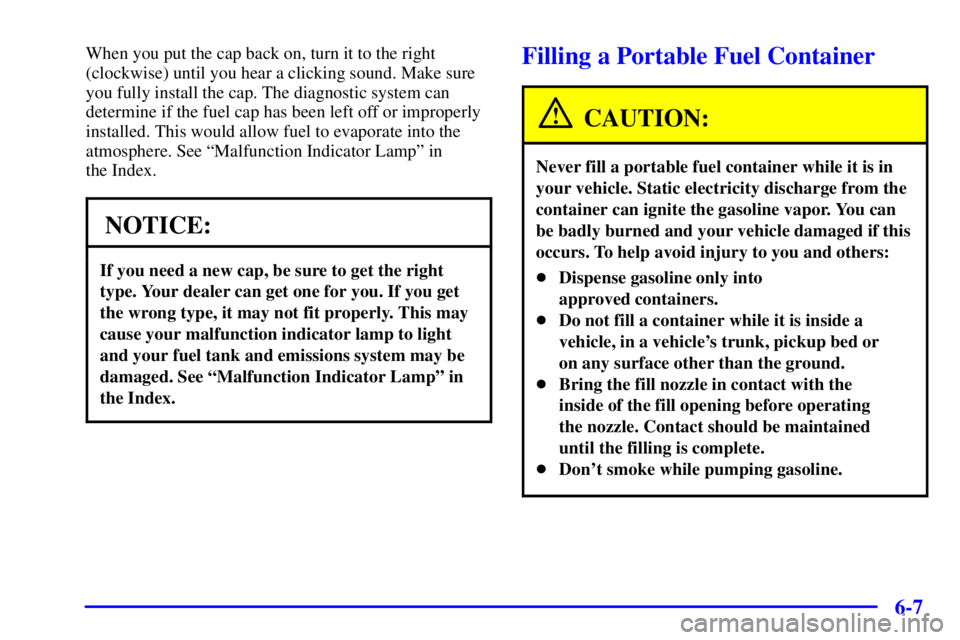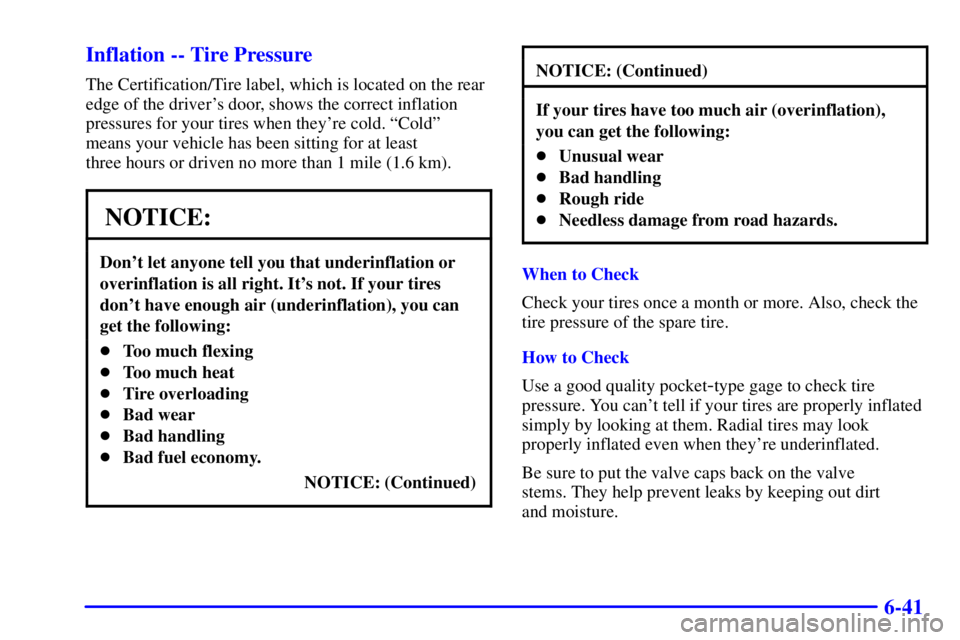Page 294 of 394
6-6
While refueling, hang the filler cap by the tether using
the hook located on the inside of the filler door.
To remove the cap, turn it slowly to the
left (counterclockwise).
CAUTION:
If you get gasoline on yourself and then
something ignites it, you could be badly burned.
Gasoline can spray out on you if you open the
fuel filler cap too quickly. This spray can happen
if your tank is nearly full, and is more likely in
hot weather. Open the fuel filler cap slowly and
wait for any ªhissº noise to stop. Then unscrew
the cap all the way.
Be careful not to spill gasoline. Clean gasoline from
painted surfaces as soon as possible. See ªCleaning the
Outside of Your Vehicleº in the Index.
Page 295 of 394

6-7
When you put the cap back on, turn it to the right
(clockwise) until you hear a clicking sound. Make sure
you fully install the cap. The diagnostic system can
determine if the fuel cap has been left off or improperly
installed. This would allow fuel to evaporate into the
atmosphere. See ªMalfunction Indicator Lampº in
the Index.
NOTICE:
If you need a new cap, be sure to get the right
type. Your dealer can get one for you. If you get
the wrong type, it may not fit properly. This may
cause your malfunction indicator lamp to light
and your fuel tank and emissions system may be
damaged. See ªMalfunction Indicator Lampº in
the Index.
Filling a Portable Fuel Container
CAUTION:
Never fill a portable fuel container while it is in
your vehicle. Static electricity discharge from the
container can ignite the gasoline vapor. You can
be badly burned and your vehicle damaged if this
occurs. To help avoid injury to you and others:
�Dispense gasoline only into
approved containers.
�Do not fill a container while it is inside a
vehicle, in a vehicle's trunk, pickup bed or
on any surface other than the ground.
�Bring the fill nozzle in contact with the
inside of the fill opening before operating
the nozzle. Contact should be maintained
until the filling is complete.
�Don't smoke while pumping gasoline.
Page 296 of 394
6-8
Checking Things Under the Hood
CAUTION:
Things that burn can get on hot engine parts and
start a fire. These include liquids like fuel, oil,
coolant, brake fluid, windshield washer and other
fluids, and plastic or rubber. You or others could
be burned. Be careful not to drop or spill things
that will burn onto a hot engine.
Hood Release
To open the hood, first pull
the handle inside the vehicle
located under and to the left
of the steering wheel.Then go to the front of the vehicle and pull up on
the secondary hood release located near the center of
the grill.
Lift the hood.
Before closing the hood, be sure all filler caps are on
properly. Pull down the hood and close it firmly.
Page 329 of 394

6-41 Inflation -- Tire Pressure
The Certification/Tire label, which is located on the rear
edge of the driver's door, shows the correct inflation
pressures for your tires when they're cold. ªColdº
means your vehicle has been sitting for at least
three hours or driven no more than 1 mile (1.6 km).
NOTICE:
Don't let anyone tell you that underinflation or
overinflation is all right. It's not. If your tires
don't have enough air (underinflation), you can
get the following:
�Too much flexing
�Too much heat
�Tire overloading
�Bad wear
�Bad handling
�Bad fuel economy.
NOTICE: (Continued)
NOTICE: (Continued)
If your tires have too much air (overinflation),
you can get the following:
�Unusual wear
�Bad handling
�Rough ride
�Needless damage from road hazards.
When to Check
Check your tires once a month or more. Also, check the
tire pressure of the spare tire.
How to Check
Use a good quality pocket
-type gage to check tire
pressure. You can't tell if your tires are properly inflated
simply by looking at them. Radial tires may look
properly inflated even when they're underinflated.
Be sure to put the valve caps back on the valve
stems. They help prevent leaks by keeping out dirt
and moisture.
Page 355 of 394

6-67 Capacities
*Cooling System 14.8 quarts (14.0 L). . . . . . . . . . . .
*Cooling System with
Engine Oil Cooler 15.4 quarts (14.6 L). . . . . . . . .
Crankcase with Filter 6.0 quarts (5.7 L). . . . . . . . . . .
Fuel Tank
Denali 26.0 U.S. gallons (98.4 L). . . . . . . . . . . . . .
Denali XL 32.5 U.S. gallons (123.0 L). . . . . . . . . .
*Add 1.05 quarts (1 L) if equipped with rear heating.
All capacities are approximate. After refill, the levels
must be rechecked.
Normal Maintenance
Replacement Parts
Replacement part numbers listed in this section are
based on the latest information available at the time of
printing, and are subject to change. If a part listed in this
manual is not the same as the part used in your vehicle
when it was built, or if you have any questions, please
contact your GM dealer.These specifications are for information only. If you
have any questions, see the service manual for the
chassis or refer to the body manufacturer's publications.
Oil Filter* PF59. . . . . . . . . . . . . . . . . . . . . . . . . . . . . .
Engine Air Cleaner/Filter* A1518C. . . . . . . . . . . . . . .
Passenger Compartment
Air Filter Kit** 52485513. . . . . . . . . . . . . . . . . . . .
PCV Valve* CV948C. . . . . . . . . . . . . . . . . . . . . . . . .
Spark Plugs PTZ16R15 Denso***. . . . . . . . . . . . . . .
PZTR5A15 NGK***
Fuel Filter* GF626. . . . . . . . . . . . . . . . . . . . . . . . . . . .
Wiper Blades (Front)** 15706394. . . . . . . . . . . . . . .
Wiper Blade Type (Front) ITTA. . . . . . . . . . . . . . . . .
Wiper Blade Length (Front) 22.0 inches (56.0 cm). . .
Wiper Blades (Rear)** 22154396. . . . . . . . . . . . . . . .
Wiper Blade Type (Rear) ITTA. . . . . . . . . . . . . . . . . .
Wiper Blade Length (Rear) 18.0 inches (45.0 cm). . .
* ACDelco
� Part No.
**GM Part No.
***Spark Plug Gap is 0.060 inches